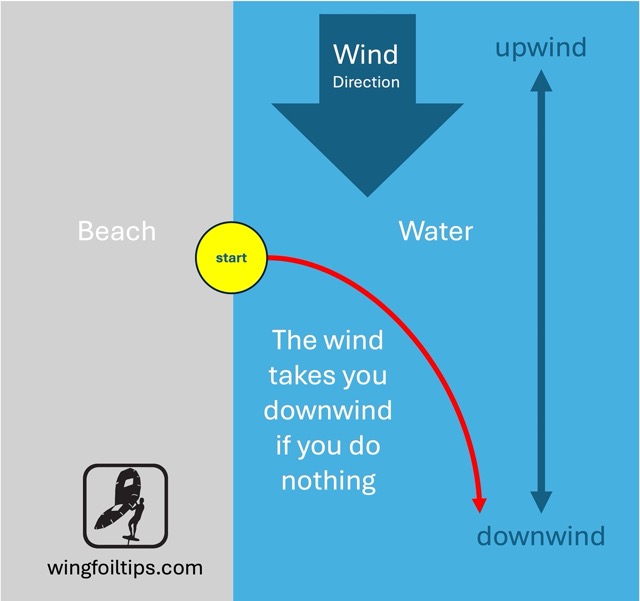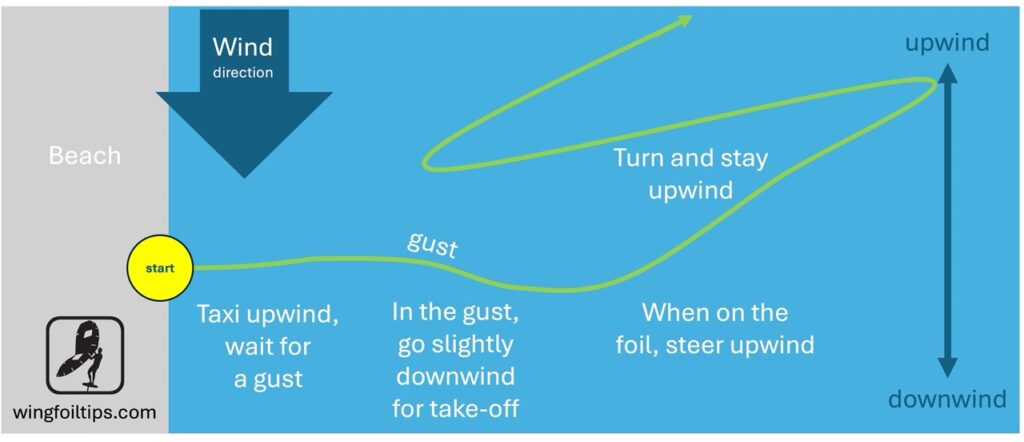When you start learning how to wingfoil going upwind is a big issue. You will be on your knees a lot in the beginning, you start standing up and then you start to taxi around. After that, you will try to take-off and fly on the foil. All this happens while you drift downwind bit by bit. What happens then is what riders refer to as the walk of shame: walking all the way back on the waterline with your gear, to where you started. On this page we go into wingfoil: going upwind.

Wingfoil going upwind and downwind: the basics
If you are new to wind and watersports, you may not have heard about upwind and downwind. Here are the basics.
What is upwind and downwind?
Upwind refers to the direction where the wind comes from. Downwind refers to the direction the wind is blowing towards. Downwind is where the wind will take you if you do nothing and just “sit” on your board. It also takes you there if you are learning and don’t yet know how to manage to go upwind.
Why is it important to understand upwind and downwind?
Going downwind is a thing that automatically happens if you don’t do anything to make it not happen. The reason it’s important to understand this is that the wind will take you to places you may not want to end up, like a pier, the end of your beach, boats, a harbour and so on. That’s why it’s important to be aware of your downwind drift. Now that you know, you can act on it.
Is it bad to go downwind?
No it’s not. Actually, going downwind is a way to ride when wingfoiling and it can be a lot of fun. But when learning, it’s just important to be aware that it happens. And it’s important to know that in wingfoil going upwind is also possible. You need to have the right technique to do so.
Downwind dynamics
Here you see a schematic overview of what upwind and downwind means. If you get into the water on the yellow spot, the wind will take you in the direction of the red arrow.
That’s not an enormous problem, just be sure to know this happens and how to control and counter this. You can read below how to go upwind.

How to control downwind momentum
It’s not necessarily bad to be drifting downwind, as long as you know it happens and you control that it happens. This means you get back out the water or you are capable of sailing back upwind before you get into areas you don’t want to end up in. If you don’t know how to sail (foil) back upwind, you must have checked and know your way back walking on the beach and you don’t get lost. If you are aware of this, you are okay. But it’s always good to know how to go back upwind and how to stay upwind.
Once you have certain level of wingfoil going upwind is quite easy. You will use the downwind momentum to get on the foil. While you taxi, you stay heading upwind as much as you can, and you try to relax. You wait for the gust to come. As soon as the gust comes, you steer downwind and allow for the board to speed up. Help by pumping if needed. Once you get on the foil, turn back upwind and recover your ground.
The image below shows this dynamic of using downwind speed to get on the foil and then using the flight on the foil to get back upwind. Ideally, I would do this specific trajectory only to get on the foil when beginning the session, and then always try to stay in the upwind area of the starting point (the starting point is marked in yellow, the upwind area is below that point) for the rest of the session. This gives you margin for error and recovery if something bad happens.

Upwind and downwind in real life
Below you see a screenshot of a wingfoil session hat show how easy it is to wingfoil going upwind when you are riding a set of wingfoil equipment, once you know how to get on the foil. It’s always safer to first go upwind, stay upwind and have your fun in the upwind area. If anything happens, you can always return easier back towards your starting point from an upwind position.
One of the great aspects of wingfoiling is exactly this: it’s enormous upwind capabilities. This creates a very large playing field for riders, because you can ride in almost any direction. Especially when you know how to make longer flights, this becomes easier.

4 ways to wingfoil going upwind
- Walk upwind
Before going into the water, walk upwind and go into the water there. If you are a total beginner, you may even consider driving upwind, leaving your equipment there, driving downwind, leaving your car there, and then walk back upwind. You go into the water and you know you have plenty of margin to drift while learning. When you are a beginner at wingfoil going upwind is not easy in the water, so you may want to consider doing it on land. - Taxi upwind
If you don’t know how to get on the foil yet, but you do stand on your board, you are taxiing. While taxiing, place your back foot towards the heelside of the board and move the wing towards the back of the board. You will see the board turns upwind. It probably doesn’t go far upwind, but it will stop you from going downwind. - Paddle upwind
You can lay on your board, have the wing rest on your heels and paddle upwind. However, this seems easier than it is. - Get on the foil
The easiest way by far is to get on the foil as soon as you can. Once you are on the foil, your board accelerates. As soon as you have enough speed, you can move your wing towards the back of the board and you will go upwind. You will find out that while foiling, in wingfoil going upwind is very easy. You can recover ground like crazy!
Please note that taking off in an upwind direction is very difficult. You make your life a lot easier if you do it in a downwind direction. - Foil upwind
Once you are on the foil, you can go upwind and recover a lot of ground. What you need to do is to lean backwards a little bit, steer the front of your board towards the wind and sheet the wing in by pulling on your back arm.
See also:
- More wingfoil tutorials
- How to take off
- Wingfoil beginners guide
